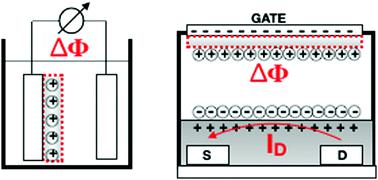当前位置:
X-MOL 学术
›
Mater. Horiz.
›
论文详情
Our official English website, www.x-mol.net, welcomes your
feedback! (Note: you will need to create a separate account there.)
About the amplification factors in organic bioelectronic sensors
Materials Horizons ( IF 12.2 ) Pub Date : 2020-01-13 , DOI: 10.1039/c9mh01544b Eleonora Macchia 1, 2, 3, 4, 5 , Rosaria Anna Picca 1, 2, 3, 4, 6 , Kyriaki Manoli 1, 2, 3, 4, 6 , Cinzia Di Franco 4, 7, 8, 9 , Davide Blasi 2, 3, 4, 6 , Lucia Sarcina 1, 2, 3, 4, 5 , Nicoletta Ditaranto 1, 2, 3, 4 , Nicola Cioffi 1, 2, 3, 4, 5 , Ronald Österbacka 4, 7, 8, 9 , Gaetano Scamarcio 4, 7, 8, 9, 10 , Fabrizio Torricelli 2, 3, 4, 6, 11 , Luisa Torsi 1, 2, 3, 4, 5
Materials Horizons ( IF 12.2 ) Pub Date : 2020-01-13 , DOI: 10.1039/c9mh01544b Eleonora Macchia 1, 2, 3, 4, 5 , Rosaria Anna Picca 1, 2, 3, 4, 6 , Kyriaki Manoli 1, 2, 3, 4, 6 , Cinzia Di Franco 4, 7, 8, 9 , Davide Blasi 2, 3, 4, 6 , Lucia Sarcina 1, 2, 3, 4, 5 , Nicoletta Ditaranto 1, 2, 3, 4 , Nicola Cioffi 1, 2, 3, 4, 5 , Ronald Österbacka 4, 7, 8, 9 , Gaetano Scamarcio 4, 7, 8, 9, 10 , Fabrizio Torricelli 2, 3, 4, 6, 11 , Luisa Torsi 1, 2, 3, 4, 5
Affiliation

|
Several three-terminal organic bioelectronic structures have been proposed so far to address the needs for a variety of biosensing applications. The most popular ones utilized organic field-effect transistors operated in an electrolyte, to detect both proteins and genomic analytes. They are endowed with selectivity by immobilizing a layer of bio-recognition elements. These features along with the foreseen low-cost for their production, make them very appealing for point-of-care biomedical applications. However, organic bioelectronic transistors do not always exhibit a performance level beyond state-of-the-art electrochemical sensors, which have been dominating the field for decades. This review offers a perspective view based on a systematic comparison between the potentiometric and amperometric electrochemical sensors and their organic bioelectronic transistor counterparts. The key-relevant aspects of the sensing mechanisms are reviewed for both, and when the mathematical analytical expression is actually available, the amplification factors are reported as the ratio between the response of a rationally designed transistor (or amplifying circuit) and that of a homologous electrochemical sensor. The functional dependence of the bioelectronic sensor responses on the concentration of the species to be detected enabling their correct analytical quantification, is also addressed.
中文翻译:

关于有机生物电子传感器中的放大因子
迄今为止,已经提出了几种三端有机生物电子结构,以满足各种生物传感应用的需求。最受欢迎的是利用在电解质中运行的有机场效应晶体管来检测蛋白质和基因组分析物。通过固定一层生物识别元件,它们具有选择性。这些功能以及可预见的生产成本低廉,使其非常适合即时医疗生物医学应用。但是,有机生物电子晶体管的性能水平并不总是超过最先进的电化学传感器的水平,而电化学传感器已经在该领域占据了数十年的历史。这篇评论提供了基于电位计和安培计电化学传感器及其有机生物电子晶体管对应物之间系统比较的透视图。两者都对传感机制的关键方面进行了审查,并且当数学分析表达式实际可用时,放大系数被报告为合理设计的晶体管(或放大电路)的响应与同源晶体管的响应之间的比率。电化学传感器。还解决了生物电子传感器响应对要检测的物种的浓度能够实现正确分析定量的功能依赖性。当数学分析表达式实际可用时,将放大系数报告为合理设计的晶体管(或放大电路)的响应与同源电化学传感器的响应之间的比率。还解决了生物电子传感器响应对要检测的物种的浓度能够实现正确分析定量的功能依赖性。当数学分析表达式实际可用时,将放大系数报告为合理设计的晶体管(或放大电路)的响应与同源电化学传感器的响应之间的比率。还解决了生物电子传感器响应对要检测的物种的浓度能够实现正确分析定量的功能依赖性。
更新日期:2020-01-13
中文翻译:

关于有机生物电子传感器中的放大因子
迄今为止,已经提出了几种三端有机生物电子结构,以满足各种生物传感应用的需求。最受欢迎的是利用在电解质中运行的有机场效应晶体管来检测蛋白质和基因组分析物。通过固定一层生物识别元件,它们具有选择性。这些功能以及可预见的生产成本低廉,使其非常适合即时医疗生物医学应用。但是,有机生物电子晶体管的性能水平并不总是超过最先进的电化学传感器的水平,而电化学传感器已经在该领域占据了数十年的历史。这篇评论提供了基于电位计和安培计电化学传感器及其有机生物电子晶体管对应物之间系统比较的透视图。两者都对传感机制的关键方面进行了审查,并且当数学分析表达式实际可用时,放大系数被报告为合理设计的晶体管(或放大电路)的响应与同源晶体管的响应之间的比率。电化学传感器。还解决了生物电子传感器响应对要检测的物种的浓度能够实现正确分析定量的功能依赖性。当数学分析表达式实际可用时,将放大系数报告为合理设计的晶体管(或放大电路)的响应与同源电化学传感器的响应之间的比率。还解决了生物电子传感器响应对要检测的物种的浓度能够实现正确分析定量的功能依赖性。当数学分析表达式实际可用时,将放大系数报告为合理设计的晶体管(或放大电路)的响应与同源电化学传感器的响应之间的比率。还解决了生物电子传感器响应对要检测的物种的浓度能够实现正确分析定量的功能依赖性。











































 京公网安备 11010802027423号
京公网安备 11010802027423号